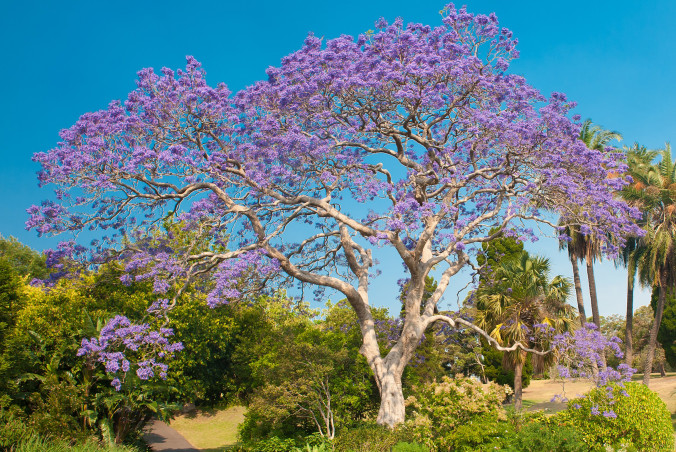I can’t let November pass without mentioning the stunning jacaranda trees, now so much a feature of Sydney’s cityscape. The jacaranda tree’s hold on Sydney and its imagination is now so well entrenched that the tree is often mistaken for an Australian native. It’s actually indigenous to south America.
The species most commonly planted in Sydney, Jacaranda mimosifolia, was collected and taken to the Royal Gardens at Kew, England, in about 1818. One early source gives the credit to plant hunter Allan Cunningham, who was sent on from Rio de Janiero to NSW, where he would later briefly serve as colonial botanist.
Arguably Grafton is the jacaranda capital of Australia. From mid-October and mid-November, the streets and parks of this Northern NSW city are transformed into something out of a dream when the jacaranda trees explode in all their purple glory. From 18 October to 10 November is Grafton’s ‘Official’ Jacaranda 2019 season and includes the city’s Jacaranda Festival billed as beautiful, welcoming, fun, creative – a little bit crazy with Jacaranda Queens to Drag Queens – and everything in between.
Jacaranda is a genus of 49 species in the family Bignoniaceae, native to tropical and subtropical regions of South America and the Caribbean. It has been planted widely and is quite common in southern California, Florida, Argentina, South Africa, Zimbabwe, Australia, New Zealand, Italy, Portugal, Spain and Zambia.
November is jacaranda season in Sydney. Seen from the harbour or the land, no other blossoming has such a transformative an effect on the city. The trees were a popular civic planting in the beautification programs of the early 20th century and interwar years, right up to the 1950s and 1960s.
Jacaranda trees create mauve necklaces for boulevards and canopies over narrow suburban streets. As the petals fall, they lay a purple carpet underneath a joy to all except neat-freaks and occasional mean-spirited motorists complaining about stains on the paintwork.
Kirribilli, Sydney … Jacaranda trees create mauve necklaces for boulevards and canopies over narrow suburban streets.
It’s difficult now to imagine a time when jacarandas did not rain purple on Sydney streets. But though the odd tree was grown in private gardens from the 1850s, most were familiar only with the specimen in the botanic gardens.
Like other members of the Bignonia family, jacarandas are difficult to grow from cuttings, though they grow readily from freshly fallen seed. Colonial horticulturists were likely working with cuttings from established trees that hadn’t yet flowered, or old seeds that had deteriorated on the high seas en route from England or Brazil.
All this meant that in its early years as an Australian import, the jacaranda was considered one of the rarest as well as the most beautiful of trees. That changed in 1868, when landscape designer Michael Guilfoyle solved the riddle of propagation. The method involves cuttings and cold pits, bell jars and bottom heat – enough to daunt even the most passionate of green thumbs.
By the 1930s, the jacaranda was so common that some forgot it had ever been anything other than ours: a real estate listing for a Wahroonga bungalow describes English oaks and ‘native jacarandas’ growing side by side. In the same decade, Sydney’s society pages started reporting young ladies wearing gowns of jacaranda blue.
